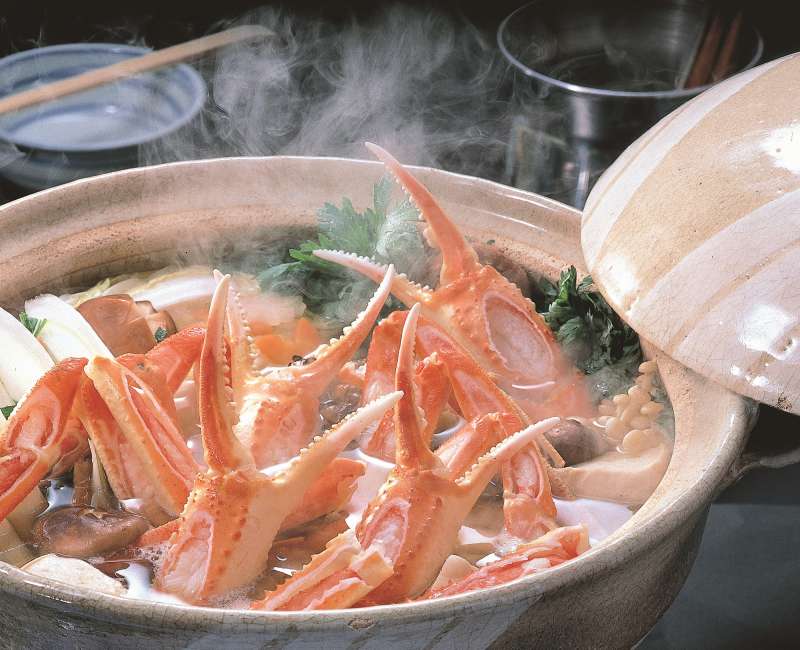
Story A Family Trip to Japan’s San’in — A Relaxing World Heritage Hot Spring Paradise & Enjoy Snow Crab, Japan’s Winter Specialty By JNTO on 08 November 2024

Many travel to Japan during winter but not many know of this lesser-known destination, San’in, on the main island of Japan.
Strolling through the 19th-century streets of San’in, it’ll feel like time has come to a standstill. As you stare in awe of ancient architecture that has blended seamlessly with modern structures, you will be reminded of the historical significance this region holds in Japanese culture. Characteristic wooden beams, paper windows, and thick thatched roofs line the narrow streets, reflecting the deep connection between man and nature.
Winter is one of the best times to experience the rich culture of San’in. As you immerse yourself in its historical heritage, you will be surrounded by snow-covered thatched roofs and cool weather. Savour some local winter delicacies and warm yourself in Japan’s soothing hot springs!
Renowned for their mineral-rich waters and believed to have healing properties, Japan’s hot springs are a highlight of family trips. In San’in you can find Yunotsu Onsen — a historic hot spring town that lies within the designated Iwami Ginzan World Heritage Site area. The warm waters are perfect for families looking to unwind after a day of exploring.
Complimenting their unique cultural experience are the coveted Matsuba crabs — a Japanese winter delicacy freshly caught from the region’s expansive coastline!
Iwami Ginzan Silver Mine

Although the San’in region is home to several UNESCO World Heritage Sites, the Iwami Ginzan Silver Mine is one of the most notable due to its interconnectedness with nature. Locals have preserved the natural landscape, creating a spectacular vista of green hills and rivers surrounding the mine. The sustainable methods employed to minimise environmental degradation were unusual for mining operations of that scale, especially during the Edo era. Families can enjoy a fun day of outdoor exploration while soaking in the cultural heritage, perfect for creating lasting memories together.
The mine stretches across a vast area, and the ‘silver roads’ that were once used to transport silver are now hiking trails! But, to fully enjoy the one-and-only Yunotsu Onsen (Hot Spring), it is recommended to also explore the area surrounding the coastal town of Oda.
Iwami Ginzan Silver Mine Ruins
Address: 183, Omori, Oda, Shimane Prefecture, Japan
Website: https://www.japan.travel/en/world-heritage/iwami-ginzan-silver-mine/
Yunotsu Onsen

Yunotsu Station, located in the seaside town of Oda, is accessible via the Japan Rail (JR) San’in Main Line. With history spanning 1,300 years, Oda is one of the oldest hot spring towns in Japan. It is said that pilgrims, traders, and even samurai frequented this town.
The town is connected to the Iwami Ginzan Silver Mine by a ‘silver road’ that passes through Okidomari Port. Arguably, Oda held great importance for miners who, centuries ago, walked the ‘silver road’ to relax their tired bodies in the mineral-rich Yunotsu hot springs. This further solidifies the significance of Oda in the region’s history.

Travel through time and walk the hot spring path that thousands have walked before! After exploring the mines, weary travellers can rest and rejuvenate in the superbly preserved onsens. Yunotsu Onsen is the only onsen in Japan that resides within a UNESCO World Heritage Site. The healing properties of the hot springs make it an ideal spot for families to recharge and bond!
Yunotsu Onsen
Address: 〒699-2501 Shimane, Oda, Yunotsucho Yunotsu, 7-1, Japan
San’in Matsuba Snow Crab

Snow crab is a winter delicacy in Oda and throughout the broader San’in region, which spans both Tottori and Shimane prefectures. This delicacy is known by different names across the Japan Sea Coast, depending on where they’re harvested. Snow crabs caught along the San’in coast are branded as Matsuba-gani (male snow crab) and Kobako-gani (female snow crab).
In coastal areas like San’in, crab harvesting has become a way of life for many and plays an important part in the area’s food traditions and culinary tourism. Matsuba-gani has gained regional renown, allowing it to be sold at premium prices - much like the esteemed Kobe beef.

©Tottori Pref.
These crabs are harvested during the winter months, from November to March, when the flesh is at its most plump and flavourful thanks to the cold currents. Matsuba-gani are packed with firm and sweet flesh, while Kobako-gani are prized for their uchiko (ovaries) and sotoko (roe). The promise of fresh catch attracts both local and overseas tourists to enjoy various dishes, including Shabu Shabu, Crab Kaiseki, Sashimi, and grilled crab.
Tottori City is home to numerous restaurants that serve Matsuba-gani snow crab. Families can look forward to Crab Festivals and themed events showcasing their specialty snow crab dishes when traveling through San’in during the winter.
It is recommended that travellers delve into the gastronomic experience and savour as many variations of Matsuba-gani as possible. Take in the sights of this charming coastal region while strolling down the streets and restaurant-hopping!
San’in is an ideal winter destination for families looking to enjoy unique experiences together, from soaking in hot springs to savouring local delicacies. The rich culture and stunning landscapes create a perfect setting for creating cherished memories during your trip to Japan.
as of 8 November 2024
















































